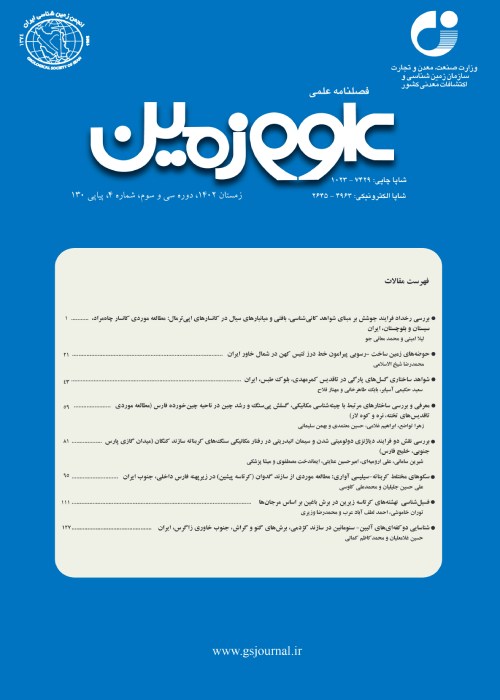The Using of Field and Microstructural Evidences in Determination of the Origin of Magmatic Enclaves and Metapelitic Xenoliths in Malayer Plutonic Complex (West Of IRAN)
Author(s):
Abstract:
The results of field studies (i.e. shape, dimensions, spatial distribution, condition of enclaves and xenoliths in the host rocks at available outcrops) experimental observations (i.e. petrographical and microstructural study of enclaves and xenoliths and whole rock geochemistry of magmatic encalves) show that magmatic enclaves are mafic and felsic types, while xenoliths are hornfelsic. Elongation of magmatic enclaves and hornfelsic xenoliths along their apparent longitude axis in the margin of intrusive body are attributed to influence of stress on enclaves in melt or semi-solid phases and xenoliths in plastic form. In addition, this is related to impact of high force of magmatic flow in contact with metamorphic wall rocks. This indicates that the origin of xenoliths is the metamorphic rocks which lie at the periphery of the intrusive body. Existing of aligned mafic enclaves in the host, in addition to, presence of signs of plastic deformations (in microscopic scale) in micro-scale fluid features can be attributed to superimposition of solid-state deformation on magmatic flow. Due to lack of solid-state plastic deformation evidences, applicability of magmatic flow criteria and distinguishable interface of magmatic enclaves with host rocks in microscopic and macroscopic scales, spherical, globular, ellipsoidal and spindle shapes of mafic magmatic enclaves attributed to presence of theirs as mafic globule and packets in the host felsic magma, and also their similarity in superficial appearance, textural, mineralogy and geochemistry with the host rock, attributed to their different origin and magma mixing event. The formation of irregular shaped magmatic felsic enclaves with recognizable mineralogical and geochemical similarity to the host rocks, which are observed at the periphery or ceiling of the plutons, related to peripheral interruption in the primary phase of magmatic injection caused by the high pressure of consecutive injection pulse and replacement of new magmatic charge.
Language:
Persian
Published:
Geosciences Scientific Quarterly Journal, Volume:19 Issue: 76, 2010
Page:
9
magiran.com/p844743
دانلود و مطالعه متن این مقاله با یکی از روشهای زیر امکان پذیر است:
اشتراک شخصی
با عضویت و پرداخت آنلاین حق اشتراک یکساله به مبلغ 1,390,000ريال میتوانید 70 عنوان مطلب دانلود کنید!
اشتراک سازمانی
به کتابخانه دانشگاه یا محل کار خود پیشنهاد کنید تا اشتراک سازمانی این پایگاه را برای دسترسی نامحدود همه کاربران به متن مطالب تهیه نمایند!
توجه!
- حق عضویت دریافتی صرف حمایت از نشریات عضو و نگهداری، تکمیل و توسعه مگیران میشود.
- پرداخت حق اشتراک و دانلود مقالات اجازه بازنشر آن در سایر رسانههای چاپی و دیجیتال را به کاربر نمیدهد.
In order to view content subscription is required
Personal subscription
Subscribe magiran.com for 70 € euros via PayPal and download 70 articles during a year.
Organization subscription
Please contact us to subscribe your university or library for unlimited access!


